If you have been using Litespeed plugin, you must have heard about quic.cloud CDN at some point in time. You must have asked how quic.cloud CDN improves the TTFB of your WordPress website and improves the loading speed of the website. But does it actually improve the website speed and TTFB (Time to First Byte)? Let’s all know in this Quic.cloud CDN review.
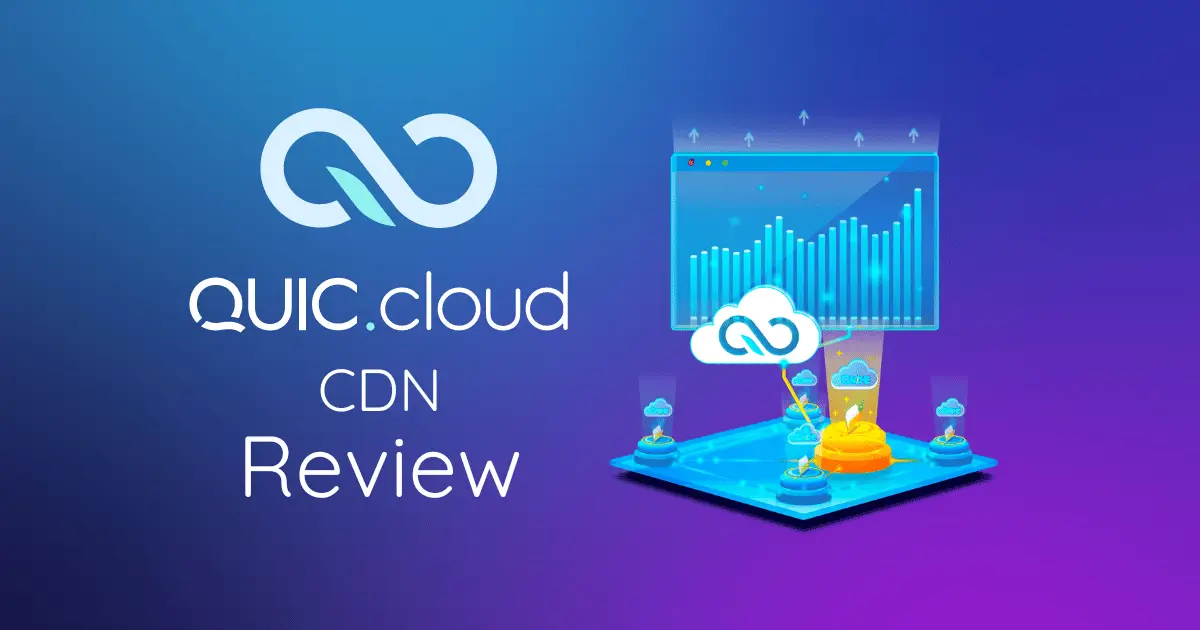
In my quic.cloud review I am going to review a few points that might help you choose a better CDN, and also compare Quic.cloud with some popular CDNs like Cloudflare and Bunny CDN. Which CDN is best for your site and which CDN you should use for your website?
If you want to make your website load faster, please check out 11 Ways to Speed Up WordPress Website.
What is Quic.cloud CDN and Why it is so popular?
Quic.cloud CDN is a reverse proxy CDN (Content Delivery Network) built just for WordPress that comes with the ability to cache both static and dynamic content. Dynamic caching such as caching HTML pages on CDN improves the loading speed of the website. This dynamic caching improves the TTFB of the website.
Quic.cloud is quite different from other typical CDNs like Bunny.net, KeyCDN, Stackpath etc. because other CDNs only cache static files like images, CSS and JS whereas quic.cloud only caches static files. Along with doing this, it also caches pure HTML pages.
Currently, Quic.Cloud only works on WordPress websites and is compatible with LiteSpeed plugin. It by default supports HTTP/3 which is the latest HTTP version which provides a faster and more secure web browsing experience.
If you want to use Quic.cloud CDN, you will have to use LiteSpeed Cache plugin on your WordPress website.
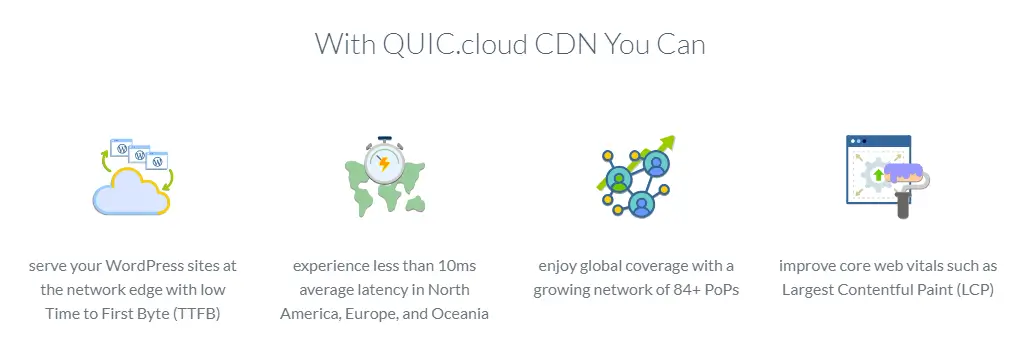
Quic.cloud vs Cloudflare vs Bunny(Other)
Cloudflare and Quic.cloud are both reverse-proxy CDNs while Bunny CDN works like a typical CDN(Which caches CSS, JS, Font, Images etc files).
- Quic.Cloud CDN comes with HTML caching which makes the website load faster worldwide. You will get low TTFB worldwide because Quic.cloud also loads HTML and Dynamic content from its CDN edge network. Most of the CDNs like Bunny, Cloudfront etc do not have this feature yet.
- Cloudflare only caches static files in its free plan. For HTML/Dynamic Caching, you have to buy a separate Cloudflare APO add-on that costs $5/month(still has routing issue) or a Cloudflare Pro plan that costs around $25 per month which comes with APO and many speed optimization features. It also has a very powerful WAF(Web Application Firewall) which is the biggest advantage.
- Bunny is a typical CDN that only supports static file caching. There is no HTML Caching facility available in it. If your target audience is from a specific region then Bunny is useful for you. Bunny CDN is one of the cheapest and top-ranked CDNs all over the world. You can check it on CDNPerf.
| Feature | Quic.cloud | Cloudflare | Bunny |
|---|---|---|---|
| Plan | Standard | Free | Paid |
| Free Plan | Yes1 | Unlimited | Trial2 |
| PoP | 83+ | 250+ | 123+ |
| Bandwidth Cost | $0.02-0.08/GB | Free3 | $0.01-0.05/GB |
| Static Caching | Yes | Yes (Routing Issue) | Yes |
| Full Page Caching | Yes | With APO/Pro Plan Only | No |
| WAF | No | Yes | No |
| Network Protocols | HTTP/3 | HTTP/3 | HTTP/3 |
| Availability | WordPress Only4 | General | General |
| DDoS Protection | Yes | Yes | Yes |
| Required Plugin | LiteSpeed | Optional | Optional |
| DNS | Free | Free5 | Paid |
| G2 Rating | 4.4 | 4.5 | 4.8 |
- Quic Cloud CDN Free Plan has only 6PoPs in America and Europe with unlimited bandwidth. Features are limited. ↩︎
- Bunny CDN has 14 days no-commitment trial with 100GB bandwidth. ↩︎
- Cloudflare Free Plan has unlimited bandwidth but has some routing issues in South Asia regions(Read this). ↩︎
- Quic.cloud only available for WordPress with LiteSpeed Cache ↩︎
- Cloudflare DNS is one of the fastest DNS worldwide(as per DNSPerf) ↩︎
Cloudflare and Bunny CDN are available on CDNPerf website where Bunny is spotted at the top of the list. But Quic.cloud is not listed on this website so we can not show you exact data. There is another tool SpeedVital that has a CDN Performance Tracker tool for testing TTFB from different locations. As per this site, quic.cloud is the top performer with 98ms of TTFB. Cloudflare has 271 ms of TTFB.
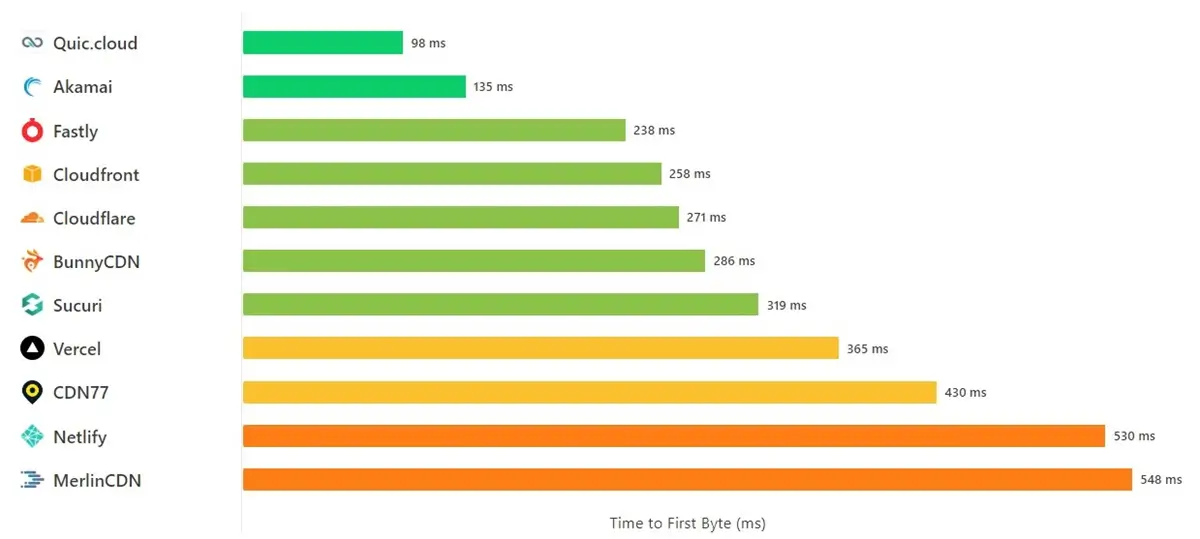
Pricing
The pricing of any CDN matters most based on its performance and features. Quic Cloud has two plans, one of which is a free plan and the other is a Standard plan which is paid. Quic.cloud free plan has unlimited bandwidth but only 6 CDN nodes are available in North America and Europe. The second plan of Quic cloud CDN is the standard plan which is paid. Initially, Quic.cloud provided some free credit.
Quic.cloud’s pricing module is pay-as-you-go i.e. you have to pay as much bandwidth as you use. Quic.cloud CDN pricing is $0.01-0.05/GB which varies by region. For this Quic Cloud Credit has to be purchased. You can also use this credit for other services of Quic.cloud.
| Region | Cost per GB in USD |
|---|---|
| North America | $0.02 |
| Europe | $0.02 |
| Russia | $0.04 |
| Latin America | $0.08 |
| Asia | $0.08 |
| Oceania | $0.08 |
| Middle East | $0.08 |
| Africa | $0.08 |
Full Page Caching
Full Page Caching is the main highlight of Quic.cloud CDN. Apart from statics file CSS, JS, Images, Fonts etc., it also caches HTML and delivers it through its network. Because of this, it is possible to deliver webpages instantly. Normal CDNs like Bunny, KeyCDN, CloudFront etc are not able to do this. Due to the Full page caching ability of Quic.cloud, it reduces the TTFB of the website and the website loads fast.
For example, if your site is hosted in the USA then generally your website will load fast for USA users. Because the distance between the server and the user is less. But if a user from India comes to this website, the website will load very slowly because the distance between the user and the server will be less.
If you use any other CDN like Bunny, KeyCDN, or Cloudflare Free CDN then it will deliver your assets files through their CDN network so that they will load fast. But HTML will still be loaded from the main server, so the response time of the website will be higher.
This problem is solved by quic.cloud. It caches the pure webpage along with the assets file. No matter if the user is from any place in the world, quic.cloud will deliver it from its CDN and hence the TTFB will be reduced.
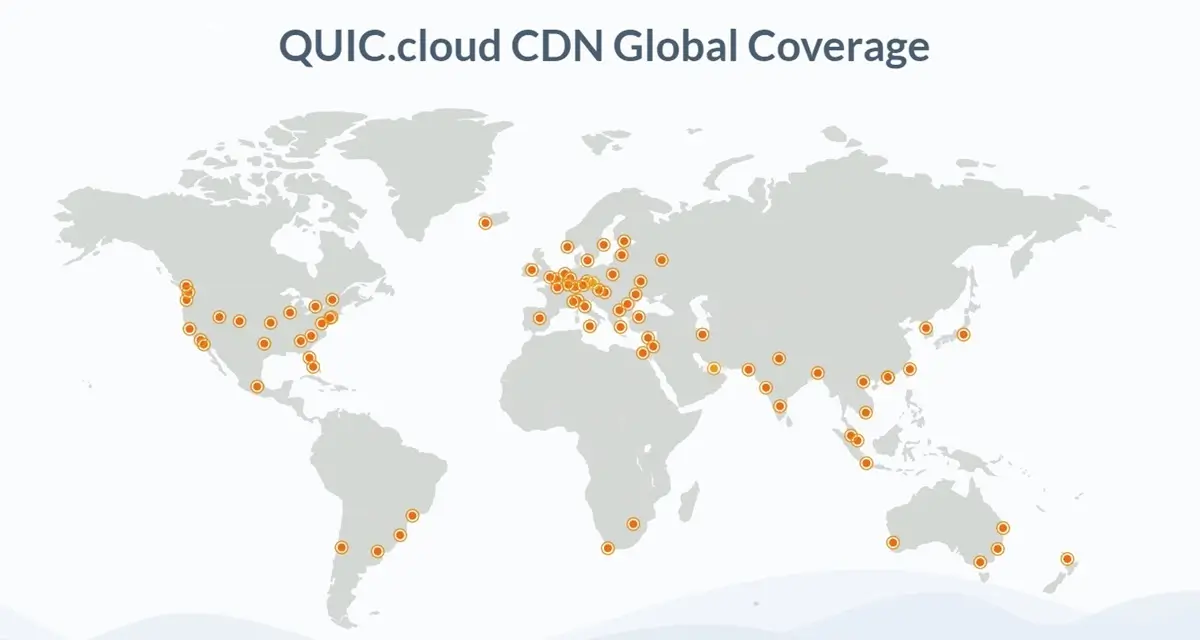
TTFB Improvements Before and After Quic.cloud CDN
It is not right to jump to any conclusion without seeing the result. Therefore, I have shown niche results regarding the testing of TTFB with the help of SpeedVitals.com TTFB testing tool and KeyCDN Performance tool.
Each test has been performed repeatedly for more accurate results. First I tested TTFB 3 times without Quic.cloud, then tested the same site URL 3 times again by activating Quic.cloud. Their before and after results are in front of you.
SpeedVitals TTFB Test
After performing TTFB test using the SpeedVitals.com Tool three times, we can clearly see green dots worldwide.
TTFB Testing Measurements –
- Green– Under 200 ms – Excellent
- Green Yellow – 200-350 ms – Good
- Yellow – 350-500 ms – Average
- Orange – 500-700 ms -Below Average
- Red – Over 700 ms – Poor
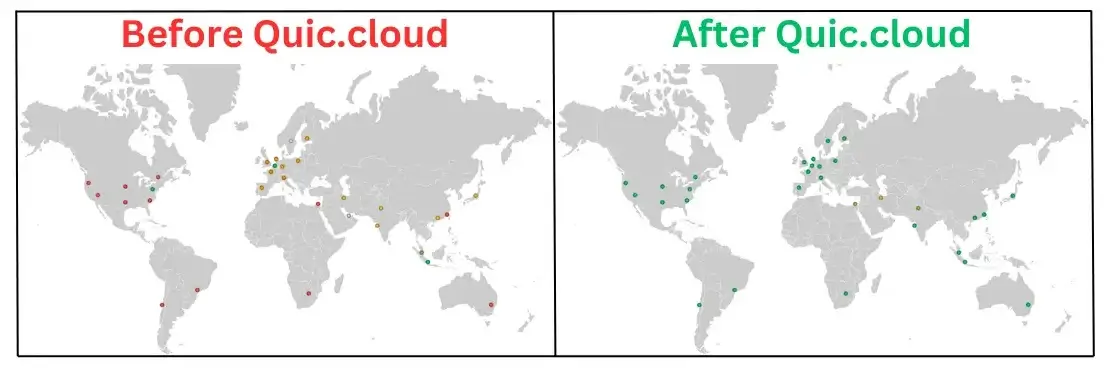


You can clearly see, the website’s TTFB time is reduced and we got 74 ms of average TTFB time. This can be considered as excellent. I got 691 milliseconds TTFB time without Quic.cloud. After activating Quic.cloud, we got only 74 ms TTFB time which is superfast.
You can check this test’s result on SpeedVital website.
KeyCDN Performance Test
Similar to SpeedVitals, KeyCDN’s Performance test is also a good TTFB testing tool that
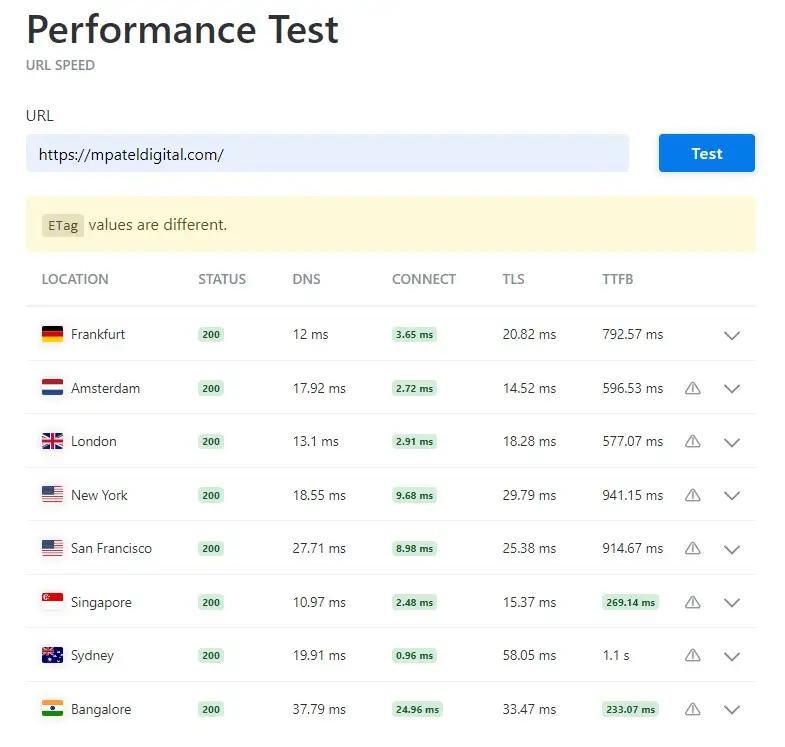

In KeyCDN’s Performance test, you can clearly see that there has been a significant reduction in TTFB at all locations after Quic.cloud was activated. This data may be different from the real world, but Quic.Cloud reduces the TTFB time. Check out KeyCDN Performance Testing Tool to test your website’s TTFB.
Quic.cloud and Core Web Vitals
Google has created Core Web Vitals matrix to measure the speed and experience of any website. Is Core Web Vitals. Core Web Vitals include Largest Contentful Paint (LCP), First Input Delay (INP), and Cumulative Layout Shift (CLS) matrix. LiteSpeed Cache + Quic Cloud Service can help solve In Core Web Vitals.
It caches entirely the webpage in the CDN edge network. This will Improve TTFB which helps to load the website faster. TTFB had a direct role in improving LCP score.
I think Quic.cloud CDN can improve and affect this CWV matrix directly. Quic.Cloud is the mainline service for LiteSpeed WordPress plugin but currently, I am focussing on Quic CDN, not its services.
Security
If you have ever used Cloudflare, you would know that Cloudflare provides security and the option to setup custom firewall rules. But in Quic.cloud we do not get the option to setup any kind of custom firewall rule.
However, Quic.cloud’s CDN network comes with DDoS Protection, Brute-force Login Protection, Web Application Firewall (WAF), CDN Level reCAPTCHA, Custom Blocklists using User-agent and IP as well as access to WordPress. It also provides some custom security features like XML-RPC brute-force protection etc. You can see the full list in the below screenshot.

Quic.cloud DNS
Quic cloud DNS is a free DNS service. Like Cloudflare, it is Anycast DNS service. Quic.cloud DNS is quite fast but its DNS servers are quite limited compared to Cloudflare. Even pure South Africa has only one DNS server. It also supports CNAME flattening.
I don’t see any particular reason to leave Cloudflare DNS and switch to Quic.Cloud DNS. So I would recommend you to use Cloudflare DNS with Quic.cloud CDN. Quic.cloud works well with Cloudflare DNS using CNAME.
Best Quic.Cloud Settings
I have long experience with Quic cloud CDN and never faced any issues. I use it with Cloudflare DNS(Grey-DNS Only Mode). Here are the best settings of Quic.cloud CDN that I use on almost all websites.

Ideal Setup with Quic.cloud CDN
Here are ideal setups that I use and also prefer for all who want a better and faster user experience on their website –
- DNS: Cloudflare DNS has a larger network than Quic.cloud
- CDN for Static Files: Bunny CDN because it is cheaper in some regions like Asia. It also has more PoPs than Quic.cloud network. You can skip this if not needed.
- For Dynamic Caching: Quic.cloud CDN for full-page caching. This will improve TTFB and Core Web Vitals.
My Final Thoughts on Quic.cloud CDN
Quic.cloud CDN is a good CDN network for WordPress. Due to full page caching, it makes the loading speed of the website fast. If you use LiteSpeed webserver or OpenLiteSpeed website then LiteSpeed Cache Plugin + Quic.cloud will be a better setup.
- Support: I have been using it for a long time and have not faced any significant performance issues. Although I faced a few minor problems but their support team fixed them.
- Downtime: Some time ago there was some downtime due to Quic.cloud outage.
- Higher Pricing: Quic.cloud’s Asian region pricing is $0.08/Gigabytes which is higher than BunnyCDN. If your major traffic is from South Asia then you can use Quic.cloud with BunnyCDN.
- Do not use Quic.cloud CDN with Cloudflare: Cloudflare + Quic.cloud works well but I do not suggest using both at the same time. It can create conflict. Some use Quic.cloud for HTML caching and Cloudflare for serving static files. This will decrease and increase the loading speed for static files due to the slow Cloudflare network in some regions. If you want an additional CDN for the statics file then BunnyCDN is the perfect CDN.
Hi,
Thanks for the article. I used CF CDN before and it’s okay. Now I try quic.cloud and enabled asia, eu and us, but I feel like it’s slowing me down.
I removed the CDN and it’s snappy again, the TTFB is great again, why do you think that is?
I am using quic.cloud for a long time and it working absolutly fantastic. You can check my TTFB at here – https://speedvitals.com/ttfb-test?url=https://mpateldigital.com/ (Please test twice)
How do you checked your TTFB?
Well tbh, even without checking from speedvital/ PSI it’s very noticable. Perhaps my webhosting is not very stable (shared), because this afternoon I noticed the speed drop even after disconecting the CDN.
Once again, thank you for the article, I’ll come back to read this after getting better hosting
Website resources are not available in shared hosting. Because of this their response time is not good. Therefore one should always invest in a good web hosting. However, quick.cloud, Cloudflare APO etc. full page caching helps in fixing this down side of shared hosting.
Even a high-traffic website can perform well on shared hosting with full page caching. Still, one should always use a better hosting like Cloudways, DigitalOcean etc.